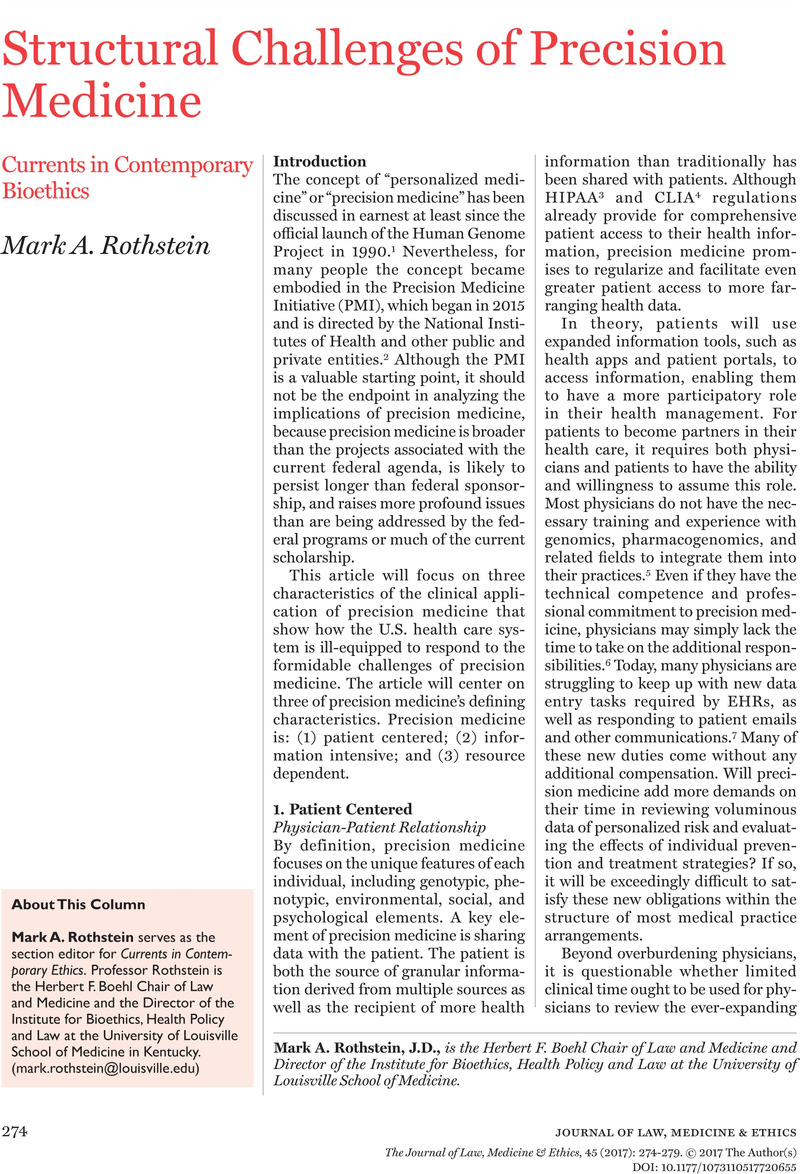Crossref Citations
This article has been cited by the following publications. This list is generated based on data provided by Crossref.
Kim, Hannah
Kim, So Yoon
and
Joly, Yann
2018.
South Korea: in the midst of a privacy reform centered on data sharing.
Human Genetics,
Vol. 137,
Issue. 8,
p.
627.
Rothstein, Mark A.
2018.
GINA at Ten and the Future of Genetic Nondiscrimination Law.
Hastings Center Report,
Vol. 48,
Issue. 3,
p.
5.
Wang, Lidong
and
Alexander, Cheryl Ann
2020.
Big data analytics in medical engineering and healthcare: methods, advances and challenges.
Journal of Medical Engineering & Technology,
Vol. 44,
Issue. 6,
p.
267.
Rothstein, Mark A.
2020.
Predictive Health Information and Employment Discrimination under the ADA and GINA.
SSRN Electronic Journal ,
Even Chorev, Nadav
2020.
Personalized Medicine in Practice: Postgenomics from Multiplicity to Immutability.
Body & Society,
Vol. 26,
Issue. 1,
p.
26.
Rothstein, Mark A.
2021.
Big Data, Surveillance Capitalism, and Precision Medicine: Challenges for Privacy.
Journal of Law, Medicine & Ethics,
Vol. 49,
Issue. 4,
p.
666.
Bakker, Elisabeth
Mol, Peter G. M.
Nabais, João
Vetter, Thorsten
Kretzler, Matthias
Nolan, John J.
Mayer, Gert
Sundgren, Anna K.
Heerspink, Hiddo J. L.
Schiel, Anja
de Vries, Sieta T.
Gomez, Maria F.
Schulze, Friedrich
de Zeeuw, Dick
and
Pena, Michelle J.
2021.
Perspectives on a Way Forward to Implementation of Precision Medicine in Patients With Diabetic Kidney Disease; Results of a Stakeholder Consensus-Building Meeting.
Frontiers in Pharmacology,
Vol. 12,
Issue. ,
Rothstein, Mark A.
2021.
Informed Consent for Secondary Research under the New NIH Data Sharing Policy.
Journal of Law, Medicine & Ethics,
Vol. 49,
Issue. 3,
p.
489.
Rayan, Rehab A.
Tsagkaris, Christos
Zafar, Imran
Moysidis, Dimitrios V.
and
Papazoglou, Andreas S.
2022.
Big Data Analytics for Healthcare.
p.
83.
Schneider, Giulia
2022.
Health Data Pools Under European Data Protection and Competition Law.
Vol. 17,
Issue. ,
p.
61.
Khurana Hershey, Gurjit K.
Sherenian, Michael G.
and
Mersha, Tesfaye B.
2022.
Allergy Essentials.
p.
25.
Aquilina, Matthew
and
Dunn, Katherine E.
2023.
Multiplexed Label‐Free Biomarker Detection by Targeted Disassembly of Variable‐Length DNA Payload Chains.
Analysis & Sensing,
Vol. 3,
Issue. 4,
Rothstein, Mark A.
2023.
Translational Bioethics and Health Privacy.
Ethics & Human Research,
Vol. 45,
Issue. 3,
p.
40.
Green, Sara
Prainsack, Barbara
and
Sabatello, Maya
2023.
Precision medicine and the problem of structural injustice.
Medicine, Health Care and Philosophy,
Vol. 26,
Issue. 3,
p.
433.
Galasso, Ilaria
2024.
Precision Medicine for Whom? Public Health Outputs from “Genomics England” and “All of Us” to Make Up for Upstream and Downstream Exclusion.
The American Journal of Bioethics,
Vol. 24,
Issue. 3,
p.
71.
Rothstein, Mark A.
2024.
Do Medically Underserved Individuals Benefit from Participating in All of Us?.
The American Journal of Bioethics,
Vol. 24,
Issue. 3,
p.
94.





